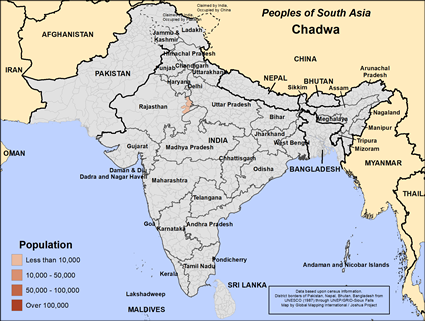Chadwa in India

Send Joshua Project a photo
of this people group. |

Map Source:
People Group data: Omid. Map geography: UNESCO / GMI. Map Design: Joshua Project
|
| People Name: | Chadwa |
| Country: | India |
| 10/40 Window: | Yes |
| Population: | 4,000 |
| World Population: | 4,000 |
| Primary Language: | Hindi |
| Primary Religion: | Hinduism |
| Christian Adherents: | 0.00 % |
| Evangelicals: | 0.00 % |
| Scripture: | Complete Bible |
| Ministry Resources: | Yes |
| Jesus Film: | Yes |
| Audio Recordings: | Yes |
| People Cluster: | South Asia Hindu - other |
| Affinity Bloc: | South Asian Peoples |
| Progress Level: |
|
Introduction / History
The Chadwa are said to belong to Hanidai sect of Sunnis and claim to be the migrants from Multan, Pakistan. The Chadwa are known for their skill and proficiency in dyeing cloths in a specific way called Chadwi. They moved to Marwar over 700 years ago along with other communities to Jodhpur and served their ruler. It is said the Magenta color was invented by a Chadwa for the Jodhpur ruler. Some of their famous patterns are: Jamra, Janjir, Jamrari, Gulnar, Chaklar, Bardev, Phool Chakker and they usually has a salient feature as a base.
Where Are they Located?
The Chadwa are a people group living in Rajasthan. The majority of them are in the Marwar area and some scattered in Mumbai, Hyderabad, Amravati, Ahmedabad, Rajkot, and other places.
The Chadwa communicate in Multani and Urdu. When it comes to business transactions they speak Hindi and Marwari.
What Are Their Lives Like?
The Chadwa are non-vegetarian. They eat mutton, beef, eggs regularly and their staple food are wheat, millet, kulthi pulses. They do not have a lot of vegetables because they transitionally live in the desert area. Interestingly, they only drink milk if necessary and most of the Chadwa do not drink alcohol due to the teachings of Islamic scriptures.
The Chadwa are purely endogamous people, meaning that they marry within their own group. They still practicing consanguineous marriage, especially cross cousin marriage, parallel cousin marriages. Marriage ceremonies are conducted in Islamic rites. Men usually get married around the age of 20-22 and women around 17-18. Marriage is between one man and one woman, but divorce is common within their close-knit society. The dowry custom is not officially sanctioned, but gifts are involved in a marriage.
Children are educated up to junior high school level. Most of them do not pursue further education to join the family business. Girls usually withdraw from school as soon as they are old enough for marriage.
The Chadwa people are a prevalent community both vertical as well as horizonal which is an essential for them to continue the family business in tie and dye work. Men hold the financial power and design work within a family unit and pass on to the sons as they get married. Women run the household and do the actual dyeing work.
What Are Their Beliefs?
There are both Hindu and Muslim people in the greater Chadwa community. As typically happens, the two religious groups do not mix. They are separate communities.
What Are Their Needs?
There are no government programs to help prompt the Chadwa specialized art or handicraft. There is no financial assistance or allotment of land for the Chadwa to pursue their handicraft. One community association called Ilakai committee and Kaum Chadwan works on all India basis. They are the only organization take cares of the smooth running of the community.
One of the Chadwai biggest threats is the mechanized printing industry. This is an immediate threat to their craft, livelihood and their entire social structure.
Prayer Points
Pray for the Holy Spirit to give the Chadwa people teachable and understanding hearts.
Pray for teams of believers to understand and to be a viable Jesus' ambassadors for the Chadwa people.
Pray that a strong movement of the Holy Spirit will bring entire Chadwa families into a rich experience of God's blessing.
Pray for the Chadwa family leaders to experience God's blessing through opening up their close-knit families for outside assistance.
Pray for the Chadwa to see the value in education for both girls and boys in advancing their previous handicraft heritage in the modern age.